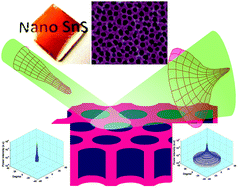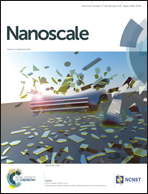Catalytically solid-phase self-organization of nanoporous SnS with optical depolarizability
Abstract
The catalytic solid-phase synthesis of self-organized nanoporous tin sulfide (SnS) with enhanced absorption, manipulative transmittance and depolarization features is demonstrated. Using an ultralow radio-frequency (RF) sputtering power, the variation of the orientation angle between the anodized aluminum oxide (AAO) membrane and the axis of the sputtered ion beam detunes the catalytically synthesized SnS from nanorod to nanoporous morphology, along the sidewall of the AAO membrane. The ultraslow catalytic sputtering synthesis on the AAO at the RF plasma power of 20 W and the orientation angle of 0° regulates the porosity and integrality of nanoporous SnS, with average pore diameter of 80–150 nm. When transferring from planar to nanoporous structure, the phase composition changes from SnS to SnS2–Sn2S3, and the optical bandgap shrinks from 1.43 to 1.16 eV, due to the preferred crystalline orientation, which also contributes to an ultralow reflectance of <1% at 200–500 nm when both the transmittance and the surface scattering remain at their maxima. The absorption coefficient is enhanced by nearly one order of magnitude with its minimum of >5 × 104 cm−1 at the wavelength between 200 and 700 nm, due to the red-shifting of the absorption spectrum to at least 100 nm. The catalytically self-organized nanoporous SnS causes strong haze and beam divergence of 20°–30° by depolarized nonlinear scattering at the surface, which favors the solar energy conversion with reduced surface reflection and enhanced photon scattering under preserved transmittance.


 Please wait while we load your content...
Please wait while we load your content...